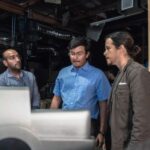Minerals—the earth’s treasures—are a finite resource. At our current rate of mineral consumption, it is projected that future generations might have to survive without them. Therefore, finding and developing renewable sources is more important than ever. Moreover, we must take care of the planet because mineral fuels have their effect on the environment. This is the essence of sustainability.
Yet, there is a gap between hardcore activists and the more seasoned industries where potential gains and improvements can still be made. Transitioning towards smart and effective energy production does not have to be in line with loss of profits.
That’s where Tom Rotmans steps in, intending to bridge this gap.
Tom, the founder of Rotmans Consultancy, deals with clients from both factions: the traditionalists and environmentalists. He knows the concerns of both parties on sustainability. Where one might need stimulation to accelerate on modern technologies, the other cares only about immediate and drastic action. These two ends don’t have to be at odds; they need to work together if we’re going to achieve real sustainability.
That is Tom’s approach to this issue as well. He believes that while traditionalists must take the environment seriously, environmentalists must also consider others’ concerns. To that end, Tom has created a blueprint to help bridge the gap between the two.
Prioritize Facts over Portrayal:
In Tom’s viewpoint, modern initiatives like SDFR and ESG Programs are mostly designed to create hype and false warranties. Their main focus is to grab attention, popularize the topic, and invigorate the emotional aspect of it. Tom advises a totally opposite approach, one that’s based on statistics, data, and facts. He wants authorities to develop initiatives that encompass all dimensions of global industries. Environment programs that are practical and feasible are the way to go.
Take a Fair Media Approach:
It’s no surprise that the media is aggressively promoting green philosophy. While that’s not a bad thing, it takes a biased approach toward portraying the efforts being made. Tom wants people to look at the positives as well instead of declaring every effort as “not enough.” Appreciate the ongoing steps taken, like cleaner production methods, nuclear developments, the potential of thorium and environmental initiatives like ocean plastic clean-up operations.
The Real Key – Collaboration:
Collaboration is the magic word here. Traditional industries can team up with sustainability experts. These experts know all about eco-friendly technologies and practices. By working together, they can develop innovative solutions that make everyone happy.
Incentivize Sustainability:
It’s also important to create incentives. Governments and organizations can offer rewards to traditional industries that adopt sustainable practices. This could be in the form of tax breaks or recognition for their efforts. Incentives give industries a reason to make positive changes.
Avoid Panic Decision-Making:
Making decisions that aggressively ban fossil fuels or making other drastic changes in how the industry operates can potentially throw us back to the Medieval Ages, Tom believes. He emphasizes that radical green initiatives can destroy the supply and demand change, creating economic problems in consumption and production. He advises that the transition to clean sources must be smooth, and fossil fuels must be smartly used in the meantime.
While Tom’s idea seems viable, we must remember that it’s not about turning everything upside down overnight. Small steps can lead to big changes.
So, how do we start? By having conversations. Let’s bring everyone to the table—traditional industries, sustainability experts, communities, and governments. Together, we can brainstorm ideas and devise plans that work for everyone.
Closing the gap between traditional industries and modern sustainability might take time and effort, but the result is worth it. We can have thriving industries that also take care of our planet.
Finally, it’s not about choosing between the old and the new. It’s about finding a balance that benefits everyone. We can make this bridge a reality by embracing innovation, education, collaboration, and incentives. So, let’s roll up our sleeves and work together for a brighter future with Tom Rotmans.
















